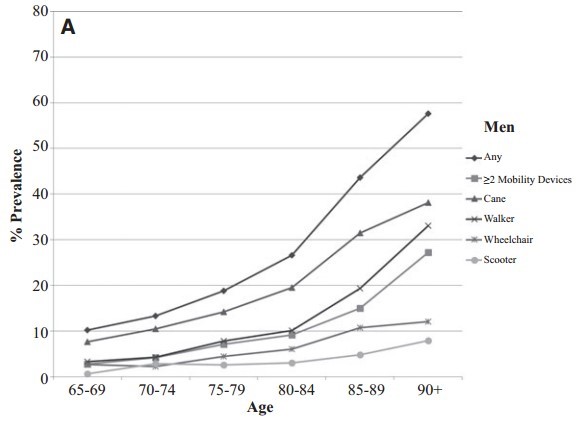Mobility device – 50 percent increased use (perhaps decreased vitamin D levels)
Mobility Device Use in Older Adults and Incidence of Falls and Worry About Falling: Findings from the 2011–2012 National Health and Aging Trends Study
“An age-adjusted comparison of results from the 1980 and 1990 National Health Interview Survey (NHIS) found a
26% increase in the use of canes, a
57% increase in the use of walkers, and a
65% increase in the use of wheelchairs at all ages”
Possible reasons include
Recognition of need to keep moving
More socially acceptable to use a mobility device
More easily used now – change of environment
Seniors living longer with a disability
Seniors have become more aware of the risk of falling
Seniors have become more vitamin D deficient
Note:
- Device use higher among blacks, Hispanics, and Obese
- (all of whom have low vitamin D levels)
Seniors who use a mobility device appeared no more likely to fall than seniors who did not.
Some previous studies have suggested that devices may actually contribute to falls.
Journal of the American Geriatrics Society. DOI: 10.1111/jgs.13393
Nancy M. Gell PhD, MPH1,*, Robert B. Wallace MD, MSc2, Andrea Z. LaCroix PhD3, Tracy M. Mroz PhD4 andKushang V. Patel PhD, MPH5
Objectives: To examine the prevalence of mobility device use in community-dwelling older adults in the United States and to investigate the incidence of falls and worry about falling according to type and number of mobility devices used.
Design: Analysis of cross-sectional and longitudinal data from the 2011–12 National Health and Aging Trends Study.
Setting: In-person interviews in the homes of study participants.
Participants: Nationally representative sample of Medicare beneficiaries (n = 7,609).
Measurements: Participants were asked about mobility device use (e.g., canes, walkers, wheelchairs and scooters) in the last month, 1-year fall history and worry about falling.
Results: Twenty-four percent of adults aged 65 and older reported mobility device use in 2011, and 9.3% reported using multiple devices within the last month. Mobility device use increased with advancing age and was associated with nonwhite race and ethnicity, female sex, lower education level, greater multimorbidity, and obesity (all P < .001). Adjusting for demographic and health characteristics and physical function, the incidence of falls and recurrent falls was not associated with the use of multiple devices or any particular type of mobility device. Activity-limiting worry about falling was significantly higher in cane-only users than in nonusers.
Conclusion: The percentage of older adults reporting mobility device use is higher than results from previous national surveys, and multiple device use is common in those who use any device. Mobility device use is not associated with greater incidence of falls. Cane-only users may compensate for worry about falling by limiting activity.


